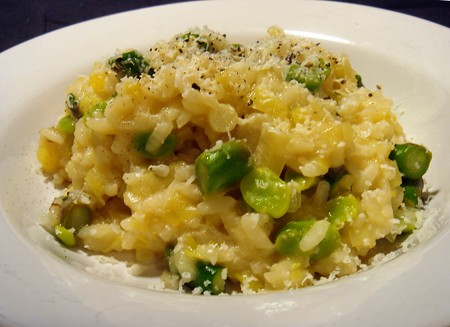
I have been a bad blogger. I have been having a simultaneously very lazy and very busy summer and one of the things I've been lazy about is keeping up here. I also haven't been doing anything very exciting in the kitchen, so that could be a contributing factor, but mostly I've been lazy about posting.
This post is actually regarding a meal I made back in early May, but, unless you live in one of the places in America where you shut down your kitchen for three months due to heat exposure, it applies year round.
See, to me, Risotto is another one of those foods that are my favorite kind of food to make. It is both comforting and luxurious, homey and foreign, and impressive yet exceptionally simple to prepare. Risotto is also a very sexy food, the first time I ever made risotto was to impress a date. When the mood strikes I still make a mean risotto, and even if I'm only impressing myself, I'm worth it.
The most important thing to remember about risotto is to keep stirring so it won't stick. Risotto is infinitely adaptable. In the past I have made pink risotto with red wine and leftover lamb, and while writing this up I thought of trying a fall risotto with chicken, apples, and a sweeter white wine. As long as you keep in mind allium (onion/leek), acid (wine/lemon juice - I may have used tomato juice and some vinegar in the past), stock (to be really traditional add saffron to the warming stock), and grain (this technique can actually be applied to almost any whole grain) everything else is up to the imagination.
Basic Risotto
Joy of Cooking's recipe for Simplest Risotto (Risotto In Bianco) with notes for adaptation and additions.
1-2 Tbs butter or olive oil (or combination), plus 1/2 Tbs butter to finish
1/2 medium onion, diced or 2 small leeks, cut into thin 1/8" half moons
4 cups stock, chicken or veggie
1 cup Italian rice or standard, medium grain white rice
1/4 dry white wine or lemon juice
1/3-1/2 cup grated Parmesan cheese
salt and pepper to taste
Optional: 1-2 cups chopped, in season vegetables, cooked meat or seafood (great use for leftovers), additional cheese (great use for odds and ends left in the fridge), herbs, or chopped nuts
1) Heat the butter or oil in a large heavy pan and soften the onions or leeks. Sauce or saute pans both work, I like to use a deep 10" frying pan with curved sides (like a pseudo wok).
2) Heat the stock to a simmer and set aside.
3) To the butter/onion combination, add the rice and cook over medium. Stir continuously until the rice becomes translucent and you can see a white spot in the center or the rice.
4) When the rice is ready, add the wine and continue stirring. If using lemon juice, reserve until after adding stock.
5) Continuing to stir, begin adding stock approximately one cup at a time. Wait until all of the liquid is absorbed before adding the next cup. After the first three cups add the last of the stock 1/4 cup at a time. Rice is ready when it still has a little tooth to it. (This will take approximately 20 minutes)
6) If adding lemon juice, stir in now and let it absorb briefly. Fold in butter and Parmesan cheese. Add in other additions now as well and season to taste.
Notes on seasonal vegetables*:
Spring: parboiled/shelled favas, asparagus, spinach, peas;
Summer: basil, corn, tomatoes, squash, green beans;
Fall: hard squash, mushrooms, sweet potatoes;
Winter: kale, leeks, brussels sprouts
*depending on the vegetable, items may need to be pre-cooked before being added to the risotto. Prepared peas or favas can be added without further prep, asparagus/ may need to be steamed or sauteed depending on sized of pieces and thickness of stems, hard squashes will need to be cooked until soft. Some or all of heartier vegetables can be cooked with the risotto instead of being added at the end.
Wednesday, August 4, 2010
Cooking to Impress - Basic Risotto
Labels:
Asparagus,
Fava Beans,
Italian,
Leek,
Risotto,
Spring,
Vegetable,
Vegetarian
Subscribe to:
Post Comments (Atom)



No comments:
Post a Comment